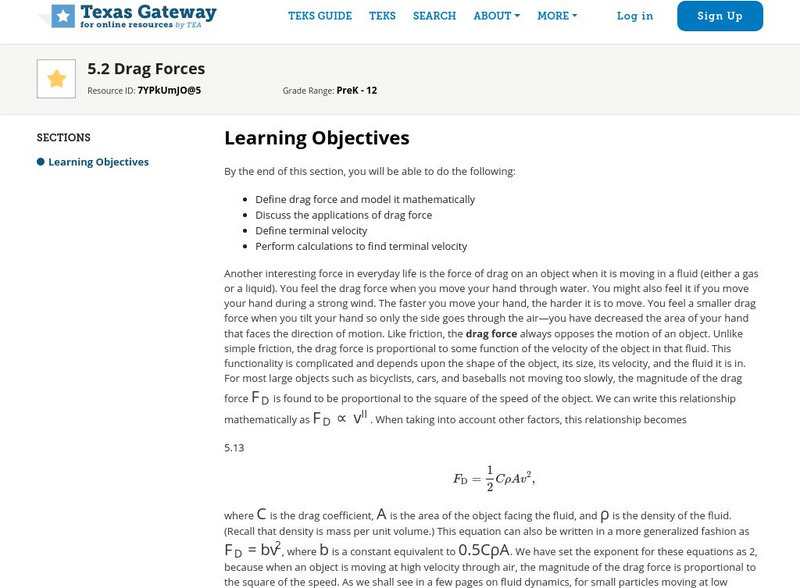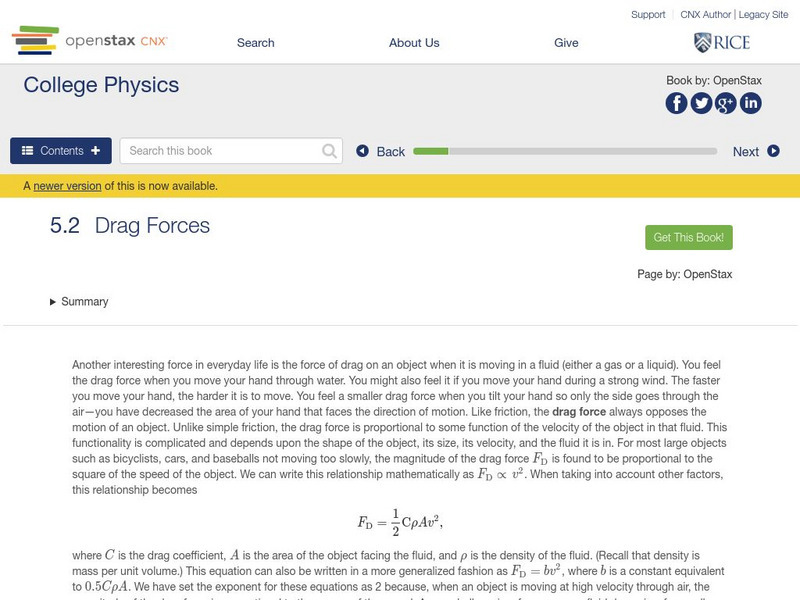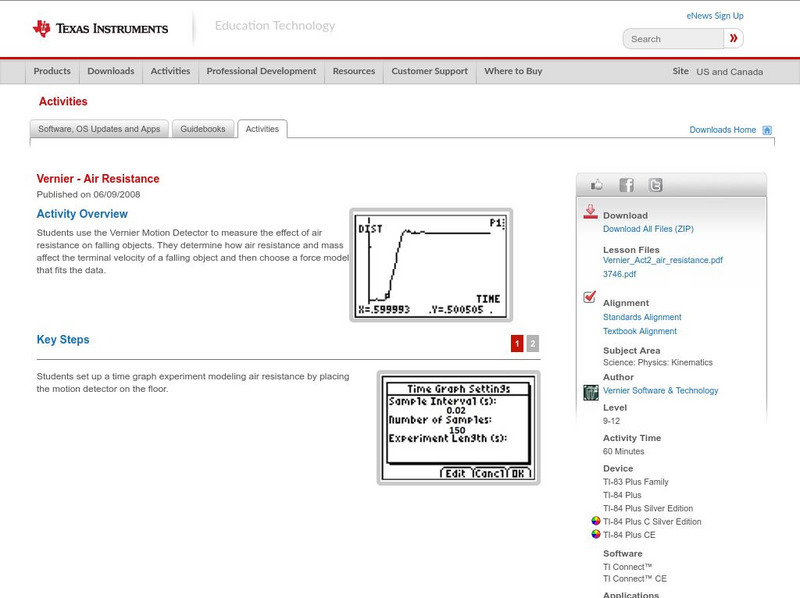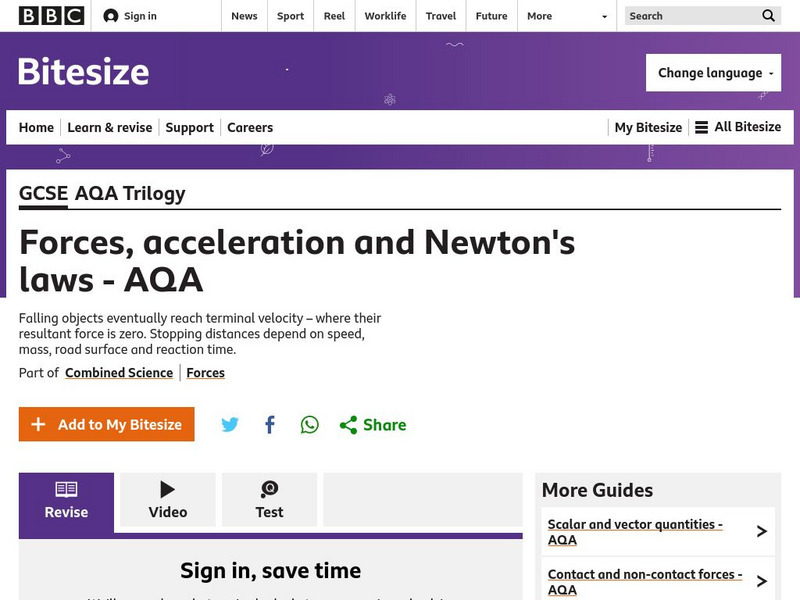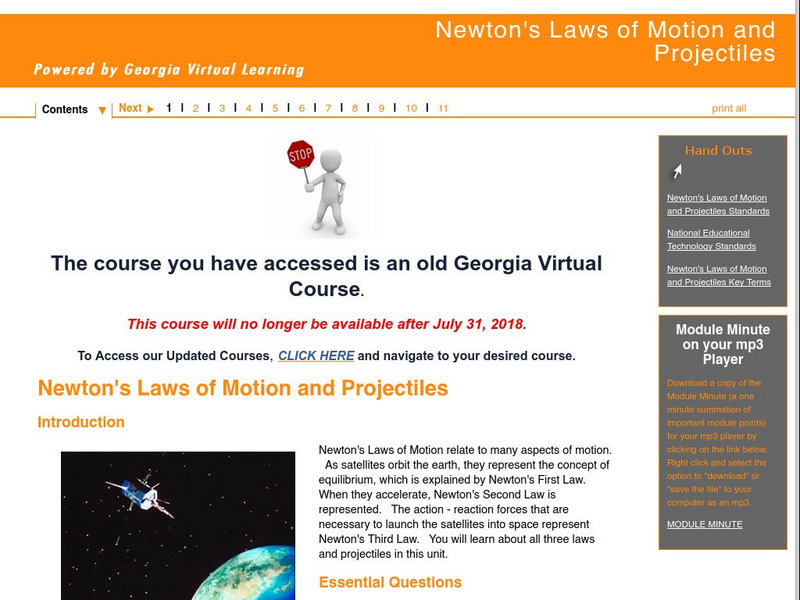University of Colorado
University of Colorado: Ph Et Interactive Simulations: The Moving Man, Motion, Velocity, Acceleration, Position
Enhance study of motion, velocity, acceleration, position and graphing with this interactive simulation.
Khan Academy
Khan Academy: Velocity and Acceleration Vectors
This 11-problem quiz/practice helps students to understand how velocity and acceleration can be represented using vectors.
BBC
Bbc: Gcse Bitesize: Newton's Laws
This lesson focuses on Newton's Law for falling objects including terminal velocity, the three stages of falling, a diagram showing what happens to the speed of a skydiver from airplane to ground, velocity-time graphs for falling...
Texas Education Agency
Texas Gateway: 5.2 Further Applications of Newton's Laws: Drag Forces
By the end of this section, you will be able to define drag force and model it mathematically, discuss the applications of drag force, define terminal velocity, and perform calculations to find terminal velocity.
OpenStax
Open Stax: College Physics: Drag Forces
In the following tutorial, students will learn how to express mathematically the drag force and also discuss its applications. They will also define terminal velocity and determine the terminal velocity given mass.
TeachEngineering
Teach Engineering: Egg Cellent Landing
The purpose of this activity is to recreate the classic egg-drop experiment with an analogy to the Mars rover landing. The concept of terminal velocity will be introduced, and students will perform several velocity calculations. Also,...
Texas Instruments
Texas Instruments: Air Resistance
Students use the Motion Detector to measure the effect of air resistance on falling objects. They determine how air resistance and mass affect the terminal velocity of a falling object and then choose a force model that fits the data.
Physics Classroom
The Physics Classroom: Free Fall and Air Resistance
This lesson in high school physics on Newton's Second Law of Motion provides a discussion of free fall and air resistance, and answers, "Why do objects which encounter air resistance ultimately reach a terminal velocity?" and "In...
NASA
Nasa: Beginner's Guide to Aerodynamics
This site from NASA uses a colorful graphic to illustrate why objects reach terminal velocity. Provides equation for the terminal velocity of an object. Graphic is accompanied by a simple explanation.
Khan Academy
Khan Academy: Particle Calculations
Apply what you've learned to calculate the position and velocity of a particle over time with this 8-problem quiz/practice.
BBC
Bbc: Gcse Bitesize: Forces, Acceleration and Newton's Laws Aqa
This lesson focuses on Newton's First Law: an object remains in the same state of motion unless a resultant force acts on it. If the resultant force on an object is zero, this means: a stationary object stays stationary; a moving object...
Science Education Resource Center at Carleton College
Serc: Calculating Air Resistance Using the Monte Carlo Method
Learners will use Vernier motion detector and Logger Pro software to first discover if air resistance of an industrial size coffee filter is a vtm or vt2m relationship (vt = terminal velocity). Once this relationship is found it will be...
University of Virginia
Uva: The Real World Air Resistance
A contrast of Galileo and Aristotle's view of inertia and motion. Describes air resistance force and how its reality seems to initially support Aristotle's view.
Georgia Department of Education
Ga Virtual Learning: Newton's Laws of Motion and Projectiles
Through informational text, interactive activities, practice problems, online labs, virtual simulations, and video clips, students learn about Newton's Laws of Motion.
Physics Classroom
The Physics Classroom: Elephant and Feather: Air Resistance
The concept of air resistance is discussed in terms of why a heavier object falls faster than a lighter object when both dropped from the same height. In this discussion and animation, an elephant and feather are used as examples.
Other
St. Chris Physics: The Physics of Skydiving
This illustration provides an overview of the scientific process of when a skydiver steps out of a plane.
NASA
Nasa: Beginner's Guide to Aerodynamics
Includes exhaustive information and a wealth of activities pertaining to aerodynamics and the physics of flight.
Physics Classroom
The Physics Classroom: Skydiving
The Physics Classroom offers this animation depicting the forces acting upon a falling skydiver.
NASA
Nasa: The Way Things Fall
This site from NASA compares free falling motion to falling with air resistance. Discusses Galileo's experiment. Explains why we believe all objects free fall with the same acceleration.





